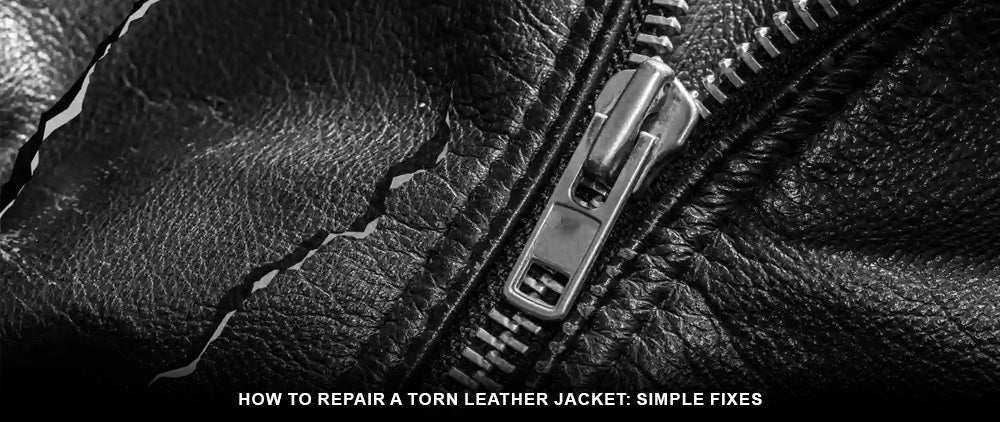Leather jackets are classic outerwear items because they are durable, fashionable, and long-lasting. But even the toughest leather jacket can get damaged.
Understanding how to repair a torn leather jacket can help you maintain its appearance and prolong its life, regardless of the cause: a snag on a sharp edge, normal wear and tear, or an unintentional cut.
So, when you think about “Can a leather jacket be repaired?”, you must know about the ways to repair it and the tools you need for it.
Need more? Read How to Restore a Leather Jacket: Tips for Reviving It and you can have the answers you need.

Identifying the Type of Damage to the Leather Jacket
You must assess the type of damage before figuring out how to repair a torn leather jacket. The most usual kinds consist of:
- Clean cuts or tears are defined by distinct, straight lines in the leather.
- Rips with sharp edges are often caused by excessive pulling or deteriorating leather.
- Peeling or cracking: This is usually caused by dryness or the use of lower-quality leather.
- Even though they are small, surface scratches can detract from appearance.
The appropriate approach and materials to use will depend on the issue at hand.

Step-by-Step: How to Fix a Leather Tear at Home
Since cuts and rips are the most frequent injuries to leather jackets, let's start with a simple one.
What You’ll Need:
- A leather repair kit for jackets
- Tweezers
- Scissors (if trimming is required)
- Leather glue or adhesive
- Sub patch (usually included in kits)
- Leather colorant (to match the original jacket)
- A soft cloth
Instructions:
- Clean the Area
Use a moist cloth or a gentle leather cleaner to clean the damaged area. Verify that there is no oil or dust. Let it completely dry.
- Trim Loose Fibers
To ensure a seamless repair, trim any frayed edges or leather strands with scissors or tweezers.
- Insert the Sub Patch
Behind the tear, slide a piece of cloth (often included in a leather repair kit). This serves as a solid foundation for the repair.
- Apply Leather Glue
Apply leather glue to the edges of the tear using a cotton swab or a small brush. Hold for a few minutes after pressing both sides together. As directed, let it dry for 12 to 24 hours.
- Blend with Leather Filler
Use leather filler over the repair if the tear leaves a dent or an uneven surface. Use a fine-grit sandpaper to gently sand it down after it has dried.
- Color Match
Cover the repair area with paint using the colorant included in your kit. Dry in between coats and apply in thin layers. Mix it with the leather around it.
- Condition and Protect
To keep the jacket supple and prevent future cracks, always use Leather Conditioners after repairs.
Pro Tip: Read our comprehensive guide on How to Soften a Leather Jacket Quickly and Safely for additional post-repair care instructions.

How to Repair Ripped Leather Jacket Edges
Stitching may be required if a seam comes loose or if the leather tears near a collar or zipper. You can sew it from the inside using a saddle stitch method if you feel comfortable using a needle and sturdy thread, preferably waxed.
Professional tailoring or relining, however, might be the best option for intricate repairs. Leather jacket relining services can support leather repairs in key areas, such as the pockets or underarms, and replace the inner fabric.
While you are fixing the ripped jacket, you may want to fix the size of it too. So, if you're wondering if leather jackets stretch, here's the guide: Do Leather Jackets Stretch? Here's What Every Rider Should Know.

How to Patch a Leather Jacket
A patch is necessary for larger holes or missing leather pieces.
Here's how to correctly patch a leather jacket:
- Cut a leather patch with a similar color and grain.
- Cover the tear with leather glue.
- For a sturdy hold, press firmly and then use a fine needle to sew around the edges.
- If necessary, blend and color.
For decorative reinforcement or elbow patches on vintage leather styles, this technique is perfect.
How to Repair a Cut in Leather
With glue and backing, a clean cut, such as one made with a knife or other sharp object, can often be repaired without any issues. However, unlike small tears, the depth of a leather cut determines how to repair a cut in leather. In addition to adhesive, deep cuts may need to be filled or sewn.

Dealing with Cracking, Peeling, or Flaking
Is the leather on your jacket flaking or cracked? Moisture restoration is the first step for how to fix a cracked leather jacket. Eventually, dry leather cracks and becomes brittle. Here's a simple solution:
- Cover the cracks with leather filler.
- After letting it dry, lightly sand it down.
- To match the original, apply leather dye.
- Apply conditioner last to seal in moisture.
Peeling may sometimes be a sign that the leather is imitation. Also, if you have a faux leather jacket, you will need to take different steps. If so, refer to our comprehensive guide on how to repair a peeling faux leather jacket and make it look new again.

How to Fix a Peeling Leather Jacket?
You might wonder if it is even possible? Well, fortunately, yes.
- Apply a small amount of leather glue or adhesive.
- The purpose of these adhesives is to fix leather.
- For the adhesive to adhere, gently press the peeling edges together and hold them firmly.
- Using a moist cloth, gently remove any excess glue, then let the product dry according to the manufacturer's directions.
Now, do you want a leather jacket replacement rather than repairing the peel of it? For this, visit our Men’s Leather Motorcycle Jackets for the best collection.
Conclusion
Repairing a torn or damaged leather jacket isn’t as difficult as it seems, especially when you have the right tools and guidance.
Whether it’s a simple tear, cracked leather, or peeling edges, timely repair and proper care can restore your jacket’s durability and charm.
For those who appreciate high-quality craftsmanship and timeless biker styles, Daniel Smart MFG offers premium leather motorcycle jackets and gear designed to last.
And if you're worried about long-term leather care, don’t miss our complete guide: Can Leather Grow Mold? Causes, Signs, and How to Remove It for essential upkeep tips.
FAQs
- Can torn leather be repaired?
A leather repair kit can be used to repair surface damage, such as scratches and scuffs. You can always fix it, but you might need some specific tools and techniques.
- What kind of glue is best for leather repair?
Flexible contact cement or leather glue with a polyurethane base is advised for the majority of leather repairs. These adhesives produce a flexible, strong, and long-lasting bond that can tolerate leather's natural wear and movement.
- Do leather repair kits actually work?
Although the outcomes vary, leather repair kits can be useful for some types of damage.
- Can a tailor fix ripped leather?
Yes, a tailor can repair a torn leather item; however, the degree of damage and the tailor's skill level will determine the difficulty and expense of the repair.
- Is it possible to repair a hole in leather?
A leather repair kit can be used to repair surface damage, such as scratches and scuffs. To fix a hole or ripped leather, a patch is needed.
- How much does it cost to repair torn leather?
Depending on the type of repair required, repairs usually cost between $35 and $250 and take 12 to 20 business days.


